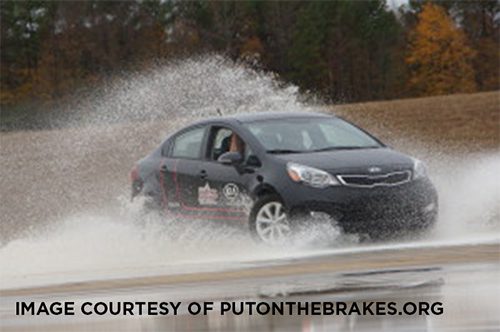2020 was a dangerous year for teens on North Carolina roads. Despite fewer cars occupying the roads due to the COVID pandemic, a total of 107 teens – 62 of them in the driver’s seat – died in car accidents in the state, which was the highest number recorded since 2011.

In this article, I’ll discuss some of the risk factors for teen drivers and provide information on a national non-profit organization offering free behind-the-wheel training in advanced safety maneuvers for teens.
Teen Car Accident Risk Rises With Additional Passengers
A common reason for teen car crashes and deaths is distraction from other passengers. There’s a reason North Carolina law limits the number of passengers and their ages in cars driven by teens – it’s dangerous!
The Centers for Disease Control released a fact sheet in 2020 on the dangers of teen drivers with teen passengers. It included the alarming finding that the presence of teen passengers increased the likelihood that unsupervised teen drivers will crash. The risk increases further with each additional teen passenger. Other findings it provided include:
-
- 16- or 17-year old drivers with passengers in the car 21 years old or under (and no older passengers in the car) are 44% more likely to be in a crash.
-
- With two or more passengers, the risk of a collision is doubled.
-
- With three or more passengers, the risk can quadruple.
Other Risk Factors That Are Elevated for Teen Drivers
The National Institute for Child Health and Human Development (NICHD) identified the following car crash risk factors that are higher among teenage drivers:
-
- Driver inexperience
-
- The presence of teenage passengers
-
- Distractions such as using a cell phone and texting
-
- Drinking and driving
-
- Nighttime driving
- Adherence to social norms – i.e. risky driving is higher among teens who report that their friends drive in a risky manner
The NICHD also found that often several of the above risk factors were present when teen drivers crashed.
Free Hands-On Driving Course for NC Teens

The instructors are professional drivers with extensive experience in advanced driver training – many who are or have been involved in professional racing, law enforcement, or movie stunt driving. The school is AAA-approved, endorsed by the National Coalition for Safer Roads, and listed among Consumer Reports’ preferred list of defensive driving schools. KIA sponsors the school by supplying the cars the teens drive during training.
B.R.A.K.E.S is headquartered in Charlotte and offers monthly training courses at the Zmax Dragway at Charlotte Motor Speedway, as well as periodically in the Raleigh area and in other states.
Attorney Brian Clemmons enrolled his teen daughter in a B.R.A.K.E.S course. “She had been somewhat of an insecure driver,” Brian said. “And, frankly, I wasn’t totally comfortable having her drive in certain situations. This course, I feel, helped develop her confidence on the road. You could see how her self-assurance soared, and she became a much better driver immediately after taking it.”
The course exposes teens to the following hazards while driving a car, but in the safety of a large protected area:
-
- Distraction Exercise
Teens are taught how difficult it is to negotiate a tightly coned course while the instructor distracts them. The course is designed to demonstrate just how dangerous cell phones, text messaging, music, traffic, and friends in the car can be.
- Distraction Exercise
-
- Accident Avoidance/Slalom Exercise
This two-part course teaches students how to make a split-second reaction to negotiate a quick, evasive lane change without losing control. It is designed to simulate an object or animal suddenly appearing in front of a car. The second part of the course is a coned slalom course where students must negotiate the vehicle around cones while focusing on weight transfer, hand positioning, and eye scanning.
- Accident Avoidance/Slalom Exercise
-
- Drop Wheel/Off Road Recovery Exercise
The drop wheel recovery course teaches students how to effectively recover from a drop wheel situation by regaining control of the car and safely returning to the roadway. Drop wheel accidents are among the highest causes of injuries and deaths across the U.S.
- Drop Wheel/Off Road Recovery Exercise
-
- Panic Stop Exercise
Teens are taught the proper technique to stop a vehicle in the shortest distance while maintaining vehicle control. Students experience first-hand the effects of an A.B.S. (Anti-Lock Braking System) and its ability to keep the wheels from locking while pulsating brake pressure.
- Panic Stop Exercise
-
- Car Control and Recovery Exercise
The skid pad course is designed to prepare teens to learn how to drive in bad weather and not to lose control. Students are taught how to properly recover from both over-steer (rear wheel) and under-steer (front wheel) skids.
- Car Control and Recovery Exercise
NC Attorneys Evaluate Car Accident Cases Free
Many of us are parents, and we understand how much is at stake when our teens get behind the wheel. If your teen has been in an accident due to the fault of another person, contact us or call 1-866-900-7078 for a free case evaluation. We also want to keep teen drivers safe, and we are here to help.
You May Also Be Interested In
Answers to the Most Frequent and Urgent Car Accident Injury Questions
Do Teens Make North Carolina’s Roads More Dangerous?
House Bill 158: Untested Teen Drivers Hit the Roads, and Parents May Be Liable for Their Accidents



